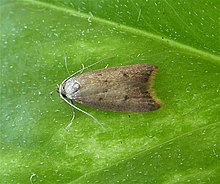카리네 V518
V518 CarinaeIC 2602(순환)에서 V518 카리네 위치 | |
| 관측 데이터 신기루 J2000.0 이쿼녹스 J2000.0 | |
|---|---|
| 별자리 | 카리나 |
| 우측 상승 | 10h 42m 14.12040s[1] |
| 탈위임 | −64° 27′ 59.1323″[1] |
| 겉보기 크기 (V) | 4.82[2] |
| 특성. | |
| 스펙트럼형 | B3/5V[3] |
| U-B색지수 | −0.58[2] |
| B-V색지수 | −0.14[2] |
| 변수형 | γ 캐스?[4] |
| 아스트로메트리 | |
| 시차 (π) | 7.19 ± 0.20[1] mas |
| 거리 | 450 ± 10 리 (105 ± 4 pc) |
| 절대치수 (MV) | −1.169[5] |
| 세부 사항 | |
| 미사 | 6.2[6] M☉ |
| 반지름 | 3.30±0.07[7] R☉ |
| 루미도 | 753[5] L☉ |
| 표면 중력 (log g) | 4.015[8] cgs |
| 온도 | 15,397[5] K |
| 회전 속도 (v sin i) | 시속 120km[8] |
| 나이 | 17[9].2 마이어 |
| 기타 지정 | |
| 데이터베이스 참조 | |
| 심바드 | 자료 |
V518 카리네(HR 4196)는 카리나 별자리에 있는 육안 변수 항성이다.카리나 성운 근처에 있는 밝은 열린 성단 IC 2602의 일원이다.
위치
V518 Carinae는 가장 밝은 멤버인 Carinae에서 5분 떨어진 오픈 클러스터 IC 2602에 놓여 있다.
변동성
518 캐리네(Carinae)는 히파르코스(Hipparcos) 광도계 분석 결과 밝기가 변하는 것으로 밝혀졌다.표시된 변동의 진폭은 0.2의 크기로, 가능한 기간은 100일과 971일이다.[11]γ 카시오페이아 변수로 분류된다.[12][4]
스펙트럼 특성
V518 카리네는 B3와 B5사이의 B형 주계열성으로 분류된다.[13]또한 헬륨별, 화학적으로 특이한 별로서 그 스펙트럼에 비정상적으로 강한 헬륨 흡수선과 상대적으로 약한 수소선으로 분류된다.그것은 아마도 파란 스트래글러일 것이다.[14]
V518 캐리네 역시 별 주위의 원반 물질로 인해 스펙트럼에 방출선이 있는 뜨거운 별인 Be 별이다.디스크로 인해 불규칙한 밝기 변화를 보이는 별은 γ 카시오페이아 변수로 분류된다.V518 Carinae는 수백일 동안 디스크 폭발을 일으키는 것으로 알려져 있다.[15]
참조
- ^ a b c Van Leeuwen, F (2007). "Validation of the new Hipparcos reduction". Astronomy and Astrophysics. 474 (2): 653–664. arXiv:0708.1752. Bibcode:2007A&A...474..653V. doi:10.1051/0004-6361:20078357. S2CID 18759600.
- ^ a b c Ducati, J. R (2002). "VizieR Online Data Catalog: Catalogue of Stellar Photometry in Johnson's 11-color system". CDS/ADC Collection of Electronic Catalogues. 2237. Bibcode:2002yCat.2237....0D.
- ^ Houk, N; Cowley, A. P (1975). "University of Michigan Catalogue of two-dimensional spectral types for the HD stars. Volume I. Declinations -90_ to -53_ƒ0". University of Michigan Catalogue of two-dimensional spectral types for the HD stars. Volume I. Declinations -90_ to -53_ƒ0. Bibcode:1975mcts.book.....H.
- ^ a b Samus', N. N; Kazarovets, E. V; Durlevich, O. V; Kireeva, N. N; Pastukhova, E. N (2017). "General catalogue of variable stars: Version GCVS 5.1". Astronomy Reports. 61 (1): 80–88. Bibcode:2017ARep...61...80S. doi:10.1134/S1063772917010085. S2CID 125853869.
- ^ a b c Silaj, J; Landstreet, J. D (2014). "Accurate age determinations of several nearby open clusters containing magnetic Ap stars". Astronomy & Astrophysics. 566: A132. arXiv:1407.4531. Bibcode:2014A&A...566A.132S. doi:10.1051/0004-6361/201321468. S2CID 53370832.
- ^ Tetzlaff, N; Neuhäuser, R; Hohle, M. M (2011). "A catalogue of young runaway Hipparcos stars within 3 kpc from the Sun". Monthly Notices of the Royal Astronomical Society. 410 (1): 190–200. arXiv:1007.4883. Bibcode:2011MNRAS.410..190T. doi:10.1111/j.1365-2966.2010.17434.x. S2CID 118629873.
- ^ Arcos, C.; et al. (March 2018). "Stellar parameters and H α line profile variability of Be stars in the BeSOS survey". Monthly Notices of the Royal Astronomical Society. 474 (4): 5287–5299. arXiv:1711.08675. Bibcode:2018MNRAS.474.5287A. doi:10.1093/mnras/stx3075. S2CID 74872624.
- ^ a b David, Trevor J; Hillenbrand, Lynne A (2015). "The Ages of Early-type Stars: Strömgren Photometric Methods Calibrated, Validated, Tested, and Applied to Hosts and Prospective Hosts of Directly Imaged Exoplanets". The Astrophysical Journal. 804 (2): 146. arXiv:1501.03154. Bibcode:2015ApJ...804..146D. doi:10.1088/0004-637X/804/2/146. S2CID 33401607.
- ^ Gullikson, Kevin; Dodson-Robinson, Sarah (2013). "Detection of Low-Mass-ratio Stellar Binary Systems". The Astronomical Journal. 145 (1): 3. arXiv:1210.6360. Bibcode:2013AJ....145....3G. doi:10.1088/0004-6256/145/1/3. S2CID 118517725.
- ^ "Hipparcos Tools Interactive Data Access". Hipparcos. ESA. Retrieved 8 December 2021.
- ^ Lefèvre, L; Marchenko, S. V; Moffat, A. F. J; Acker, A (2009). "A systematic study of variability among OB-stars based on HIPPARCOS photometry". Astronomy and Astrophysics. 507 (2): 1141. Bibcode:2009A&A...507.1141L. doi:10.1051/0004-6361/200912304.
- ^ Adelman, S. J; Mayer, M. R; Rosidivito, M. A (2000). "On the Variability of O4-B5 Luminosity Class III-V Stars". Information Bulletin on Variable Stars. 5008: 1. Bibcode:2000IBVS.5008....1A.
- ^ Skiff, B. A (2014). "VizieR Online Data Catalog: Catalogue of Stellar Spectral Classifications (Skiff, 2009-2016)". VizieR On-line Data Catalog: B/Mk. Originally Published in: Lowell Observatory (October 2014). 1. Bibcode:2014yCat....1.2023S.
- ^ Renson, P; Manfroid, J (2009). "Catalogue of Ap, Hg Mn and Am stars". Astronomy and Astrophysics. 498 (3): 961. Bibcode:2009A&A...498..961R. doi:10.1051/0004-6361/200810788.
- ^ Mennickent, R. E; Sabogal, B; Granada, A; Cidale, L (2009). "L-Band Spectra of 13 Outbursting Be Stars". Publications of the Astronomical Society of the Pacific. 121 (876): 125. arXiv:0902.4279. Bibcode:2009PASP..121..125M. doi:10.1086/597551. S2CID 119286005.




